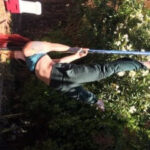The Dancing Wings Hobby T25 Cloud Dancer trainer kit caught my eye as a promising project to wrap up 2021. Marketed as an “Easy Beginner – Flying, Easy Training” model on the Dancing Wings website, it seemed like the perfect entry point for newcomers to the RC airplane hobby. Boasting a 1300mm (51.2”) wingspan and an all-up weight of 1147g (2.53 lbs), the Cloud Dancer certainly has the dimensions of a capable trainer. However, after a thorough review, it’s clear that while the Cloud Dancer is a good kit, the “beginner” label needs some clarification.
Unboxing the Cloud Dancer Kit: First Impressions
The kit arrives in a surprisingly compact box, neatly labeled with specifications and a picture of the assembled airframe. Kudos to Dancing Wings for including prominent safety precautions right on the box, including the slightly amusing warning, “Never place any portions of the model in your mouth as it could cause serious injury or even death!” – perhaps a quirky translation, but the sentiment is clear.
Inside, the box is efficiently packed with two sealed plastic bags. One contains a comprehensive hardware pack, and the other holds all the laser-cut wooden components. Alongside these, you’ll find control snakes, pushrods, a decal sheet, and a concise, two-page instruction manual.
Alt text: Compact box of Dancing Wings Cloud Dancer T25 kit, highlighting safety warnings for model airplane assembly.
The hardware pack is impressive for a kit in this category. The three foam wheels are a generous 7cm (2″) in diameter, suitable for various terrains. Control snakes utilize 20SWG wire within plastic tubes, and the provided linkages are of the same robust gauge. Overall, the hardware quality seems excellent, leaving little room for immediate upgrades.
Opening the wood pack reveals eight sheets of 1/16 ply and an assortment of balsa sheets in varying thicknesses. All wooden parts are laser-cut with precision and clearly labeled, simplifying the identification process during assembly. The quality of the wood, much like the hardware, appears to be high, promising a sturdy and well-built model.
Assembly and Build Notes: Where Experience Matters
While the component quality is commendable, the instruction manual is where the Cloud Dancer kit falls short for absolute beginners. This isn’t a kit for someone completely new to model building unless they have access to an experienced builder for guidance.
The manual relies heavily on pictorial representations of assembly steps, accompanied by brief, sometimes cryptic, text in what can be described as “Chinese English.” Crucially, it lacks detailed instructions for critical aspects like control system and motor installation. Even basic recommendations for control throws are absent.
One example of this lack of detail is a picture showing the control rods connecting to the rudder and elevator servos at a sharp 45-degree angle after a tight bend. This setup is far from ideal for smooth and efficient control movement and indicates a lack of beginner-focused instruction.
Alt text: Precision laser-cut balsa and plywood components of the Cloud Dancer T25 kit, essential for model airplane construction.
To navigate these instructional gaps, some degree of dry-fitting and pre-assembly is necessary. For instance, dry-assembling the fuselage helps determine optimal control runs and the correct orientation of formers with pushrod retaining holes. This process also raises the question of battery placement.
The intended battery location appears to be an open area within the fuselage, just behind the nose wheel. A 2200mAh 3S battery, the smallest recommended, fits snugly. While a larger battery might seem necessary, flight testing proves that the 2200mAh pack provides ample flight time.
Considering battery access, adding a hatch to the top of the fuselage above the battery compartment would offer more space for larger batteries, although, in practice, this modification proves unnecessary for typical flight durations.
Cloud Dancer in Flight: Trainer Characteristics Shine
Taking off with the Cloud Dancer is remarkably straightforward. The wide-set, large wheels ensure stable ground tracking and easy handling during taxi and takeoff. Once airborne, the model climbs quickly and requires minimal trim adjustments to achieve level flight.
My initial 8-minute flight involved a mix of circuits and camera passes, primarily at half or part throttle. The Cloud Dancer’s flight characteristics are immediately apparent: it feels lightly loaded, exceptionally stable, and predictable – exactly what’s needed in a trainer aircraft. This forgiving nature will undoubtedly build confidence in novice pilots.
Post-flight battery check revealed 62% capacity remaining after 8 minutes, confirming that the 2200mAh battery is more than sufficient. Flights of 10 minutes or more with mixed throttle usage are easily achievable. The previously considered battery hatch, while convenient, isn’t essential for practical flight operation.
Alt text: Dancing Wings Cloud Dancer T25 in flight, highlighting its stable and predictable performance as a trainer RC airplane.
Conclusion: A Recommended Kit with Caveats
Is the Dancing Wings Cloud Dancer T25 a good kit? Unequivocally, yes. Is it perfect? No. Would I recommend it? Yes, but with the crucial caveat that some prior building experience is highly beneficial.
If you can navigate the shortcomings of the instruction manual, the Cloud Dancer emerges as a well-designed model capable of taking a relatively inexperienced pilot from novice to achieving advanced flight skills. The recommended equipment package from 4-Max is well-matched to the model’s requirements.
The Good:
- Excellent handling qualities, perfectly suited for training.
- High-quality wood components, precisely laser-cut and clearly labeled.
- Comprehensive and good quality hardware pack.
- Well-designed overall, with easy assembly (aside from manual ambiguities).
- Utilizes a common 2200mAh 3S battery for good flight duration.
The Not So Good:
- Instruction manual lacks crucial details and clarity.
- Root rib dihedral angle alignment requires attention.
- No guidance on radio setup.
- Some minor design elements add unnecessary complexity.
SERVO THROWS SETUP:
| Control | Throw |
|---|---|
| Ailerons | +/- 8mm (5/8”) |
| Elevator | +/- 8mm (5/8”) |
| Rudder | +/- 12mm (1/2”) |


